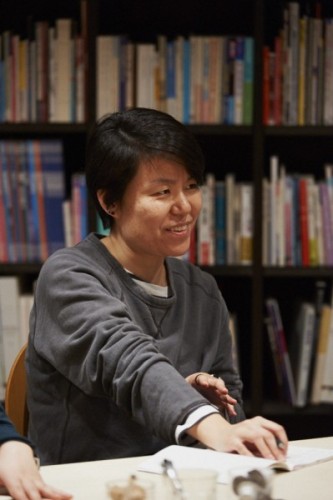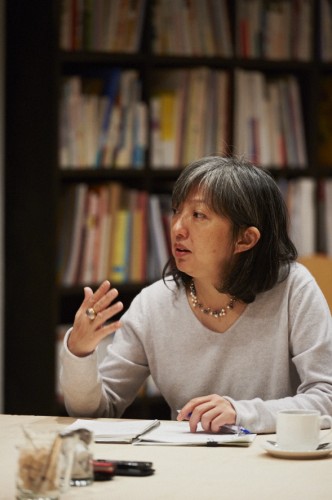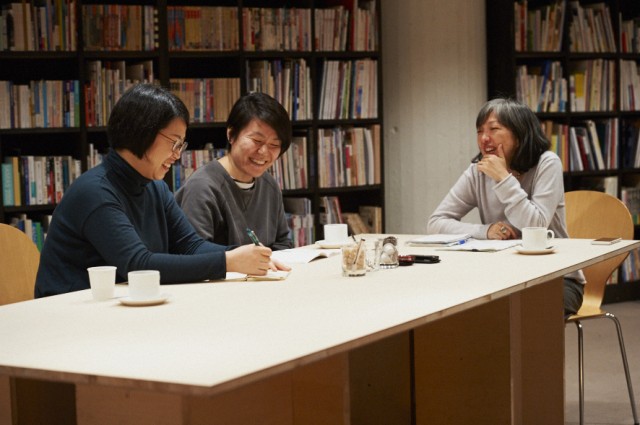
ASIA HUNDREDS is a series of interviews and conference presentations by professionals with whom the Japan Foundation Asia Center works through its many cultural projects.
By sharing the words of key figures in the arts and cultures in both English and Japanese and archiving the "present" moments of Asia, we hope to further generate cultural exchange within and among the regions.
After College and Study in the UK, Until an Encounter with Yeoseong Gukgeuk
―I came to know of the existence of yeoseong gukgeuk (Korean women's national theater) when I saw your work (Off) Stage / Masterclass in TPAM 2014. The dignified and vivid on-stage appearance of Young-sook Cho as she performed in the first half of the show was very impressive. There were various, layered viewpoints in this piece: the theatrical style called yeoseong gukgeuk, the modern and contemporary histories of Asia including Japan and Korea, what it is to be a woman, and the like. I also felt that there was a strong will to rediscover and visualize events and histories that have been forgotten or even neglected, whether intentionally or through the passage of time.
I am very much interested in the fact that, starting from the your original specialization in visual art, you then shifted to that form of performing art. I have a lot of questions, but to start, can you tell us about your name, siren eun young jung?
siren eun young jung: In English, it is written only in lowercase letters. siren is a name that I gave myself when I was a college student; it is both a nickname as well as a name that I intentionally chose thinking I'd like to be called by it. In 1993, when I entered college, the movement for democratization had been starting to lose its vigor and was transforming into a school-bound activist movement. Under that kind of circumstance, especially because I went to a women's college, the influence of the feminist movement was quite strong.
At that early stage of the feminist movement, it became a minor craze to discard one's family name and give oneself a new name as an extremely important rite of passage. All my friends around me were passionate about naming themselves anew. I assigned myself a name from Greek mythology that means "a dangerous woman." I had wanted to continue using just that name, but upon graduating and entering society, I would need an official name. In the end, after thinking hard about how I could use that name, my solution was to use siren eun young jung as my English artist name. Its all in lowercase letters so you can't determine which parts are proper nouns, and although surnames come first in Korean, I placed mine at the very end as in English conventions, and combined it with my first name, real name, and artist name, all in lowercase letters. (*1) Whenever I use this name for an exhibition or in documents that I am sending, it causes a commotion around questions of nationality, gender, and naming. I see this fuss as a kind of political play.
―By the way, what kind of names did other people give themselves?
siren eun young jung: Amongst the feminists, many called themselves "Itda" or "Ida" (being) or "Doeda" (become), or else some other name that stressed the fact that they were women. There were also some people among them who simply used the terms for female genitalia as their names. More than half of them had very aggressive names.
(*1) Korean naming conventions often separate the given name into a first syllable that may be determined by generation within a family, and a second syllable that is specific to the individual: his or her "real" name.

Photo: Jouji Suzuki
―You studied art in college, went to University of Leeds in England, and got an M.A. in Feminist Theory and Practice in the Visual Art, but I wonder if your studies abroad in England had a strong influence on your feminist thinking?
siren: I had graduated from my bachelor's program, received a masters degree from graduate school, and was already working as an artist. However, I was impatient with the feeling of staying in one place and idling within a fixed identity. Anywhere was fine, but I needed someplace to which I could escape. I didn't have any intention to study, but I heard that in England one could get a one-year visa simply by registering for a short course at an English language school. So I registered for a six month course at an English language school, got a visa, and went there intending to stay on like that. Before long I learned that the renowned feminist art historian Griselda Pollock was at the University of Leeds and visited her with the intention of enrolling at the university. Just before leaving for the UK, I had what was, for me, a very important exhibition. Every year, a museum owned by the apparel company ssamzie selects three emerging artists and organizes an exhibition of their work. I was selected and would be showing a work that year, but the subject of my work was from a novel I wrote in which a woman who lost her way suddenly disappeared completely one day. Then, after the opening of the exhibition, I myself also disappeared. Actually, I had left to travel to the UK, but I treated it like a performance in which I vanished. Without saying anything to anyone, I headed for the UK, persevered for a year there, and after visiting Griselda, she accepted me into the program. The next year I studied in the one-year master's course.
I was not so fluent in English and hadn't prepared for study at all, so the first year of the master's course was really hard. Griselda said to me, "Feminism is practice. Sitting there won't make any difference, so, in any case, you must keep creating new work." These words have become an important instruction for my life. So rather than enriching my creative practice, it was more like my studies in the UK helped me clarify what I should do, and helped me acquire the attitude that continuing to do something is, in and of itself, important.
―It It was lucky that you met such a teacher. And what sequence of events led you to encounter yeoseong gukgeuk after that?
siren: After returning to Korea from England, I continued creating work based primarily on my own experience and the experiences of the women around me. I would listen to people around me. I was born into a middle-class family and as such, had the experience of being a woman who also received an education, yet on the other hand, there was the story of a local woman who worked at the beauty salon and died from domestic violence. I was making works that could connect these two narratives, for example: works from the everyday life stories of women.
While doing that, I participated for the first time in a regionally-based, so-called community art project. The region was Dongducheon City in Gyeonggi Province, a city in which, like Okinawa in Japan, there are American military bases. My work with women who were prostituting themselves to American soldiers became my first attempt at entering into a given community. It was later that I would encounter yeoseong gukgeuk, and in the interim until I reached that point, I of course had many incidents that came to bridge this experience in Dongducheon and my later one with yeoseong gukgeuk. I suppose, although one can say I had already been working on creating works about women, the community I ended up entering was in just too difficult of a circumstance. I began to feel that my production of creative work concerning women was itself contrived, and after struggling to understand to what degree I was allowed to intervene in a given community under the name of art, and what it means to be a woman to begin with, I finally came to feel I wanted to quit making work.
It was around that time that a senior colleague of mine who specialized in performance theory, sociology, and cultural studies told me that she was going to study yeoseong gukgeuk in the context of feminist and cultural studies, and invited me to visit them with her for a change of pace. "Perhaps you'll find a different world there," she suggested.

Photo: Jouji Suzuki
siren: At the time, I hated the idea of going: I was exhausted from the class hierarchy and racism that I found during my research on Filipino women who shouldered the labor of Korean women in Dongducheon, and was gripped by a pessimistic feeling that feminist artistic activities were useless. Besides, it was a genre that had ceased to exist, and the ex-performers must all be grandmothers by now, so I was frightened, imagining how much sadness I would encounter.
Reluctantly, I visited them with her, but unexpectedly the grandmas were all very lively, and I didn't read any sadness in their faces. They remembered their heyday very well, and their remarks were more progressive than other women in their age. Even though I was an unexpected visitor, they ushered me in as if I were their granddaughter, and told me their stories. Listening to their tales I found my own mood somehow relaxed, and I quietly made up my mind to look into these people's lives.
These women considered themselves an exiled group, expelled from the main stream of Korean society, so they were also wary of outsiders. They only accepted me because I, like them, was an artist, but their community was not really that open. To prove to them that I was an artist and that I considered them artists, for two years I came to talk with them as much as possible, helping them with peeling fruit and making coffee while working hard to earn their trust. I suppose that laid the foundation for my later work with them.
―How many people were there?
siren: Including performers and fans, there were about thirty in all.
Researching Yeoseong Gukgeuk
―So you became friendly with them by communicating over the course of two years. You knew that yeoseong gukgeuk emerged in the late 1940s, flourished in the '50s and then started to decline from the '60s, and then you became acquainted with the actual performers and fans. From the time you got to know those involved in yeoseong gukgeuk until the artwork was made, what thoughts and worries did you have?
siren: I passed the first year without saying a word to anyone about my own creative activities. The next year, I gradually began keeping a record, asking each person individually as I met with them if I could take a photo or record a conversation. I was documenting the encounters.
Meanwhile, I started to think that it might be good to first create something that could provide basic information on this artistic form, since knowledge about yeoseong gukgeuk was totally absent from general society. It was around the end of 2009 that I finally started to incorporate the documentation of my meetings with them, and records I collected of commemorative photos from small yeoseong gukgeuk shows that they would occasionally perform, into my artistic work.
―In concrete terms, what kind of themes surfaced while you were listening to them and collecting documents? Reading your profile, it states that you are interested in how personal desires and existences are introduced into various world events and accordingly become some kind of resistance, become history, or assume a political character. How does this interest apply to your documentation of yeoseong gukgeuk?

Photo: Jouji Suzuki
siren: First of all, yeoseong gukgeuk had scarcely been documented, and almost no system of it remained, so the only research method available was for me to visit them one by one and listen to their stories. There was something I particularly learned through my continuing dialogue with them: that was that they happened upon that job coincidentally. In other words, they didn't have a self-awareness of the act of standing on the yeoseong gukgeuk stage as something that would have been both very political and revolutionary at the time. These were people who dreamt of performing at a time when standing on stage itself was impossible. They did not realize themselves how political their actions were, but I, looking at it now, can read that in what they did. In progressing through a research path that follows the gaps in history, for which there are no documents, I gained confidence in the idea that personal desires create politics and history.
―In your presentation for TPAM 2016, you said that the trigger for the emergence of yeoseong gukgeuk was the formation of a theater company by people who went to the geisha schools that existed during the Japanese occupation. I think you meant that the political situation in Asia at the time was related more or less to the birth of yeoseong gukgeuk. There are also female-only theatrical performance groups in Taiwan, Hong Kong, and Japan. In the case of Japan, Takarazuka started in 1914, I believe. Do you think that these examples in other countries are similarly related to the modernization of Asia and/or the political situation at the time?
siren: As for Japan, as you probably already know, Ichizō Kobayashi was the president of a railroad company, and established Takarazuka in the course of developing a railroad, modern entertainment, and modern suburbs. Consequently, it is naturally thought of as a genre that was invented in a modern situation. I haven't yet studied enough about Hong Kong, but I did look into the Taiwanese opera when I was there, so I can talk about that. Before modernization in China, men were to take on the role of defending the territory, and it was women who engaged in entertainment. Conversely, it did not appear decent for men to be involved in performance and the like. Lower-class women were sold to theater companies, and in these wandering theater companies, while performing and touring all corners of the land, a tradition of female theater came to be passed down. Taiwanese opera especially defies all the traditions of Beijing opera, rejecting the affected voice to sing in a very modern style. It appears that styles and attitudes toward performance have been molded by the process of modernization in each country.
―What do you mean by a modern singing style?
siren: A style of singing where you vocalize in a quotidian way, closer to the Western style, rejecting the long held singing traditions of affected vocalization and abstracted song that you find in Beijing opera. If you look at the female-only musical theater forms that take place in Asia, almost all leave the impression of classical traditions that have responded to the current of the times to arrive at their forms today. Only Takarazuka was created completely from the mind of a modern elite, and appears to have incorporated the modern age itself into its creation.
―It is a kind of industry.
siren: In fact, for this very reason, when I saw Takarazuka, I felt that this style that seems to be a modern invention was extremely intriguing. The British historian Eric Hobsbawm claimed that, "‘Traditions' which appear or claim to be old are often quite recent in origin and sometimes invented," but in that sense, in yeoseong gukgeuk and Taiwanese opera there is a desire to try and enclose themselves within the frame of tradition. However, Takarazuka shook itself free of tradition, clearly demarcating the boundary of modern art, and, perhaps I should say, embodying true modern values. I think that perhaps, for this very reason, there is a part of it that extremely and rigidly rejects change.

Photo: Jouji Suzuki
- Next Page
- Making Work From Yeoseong Gukgeuk






